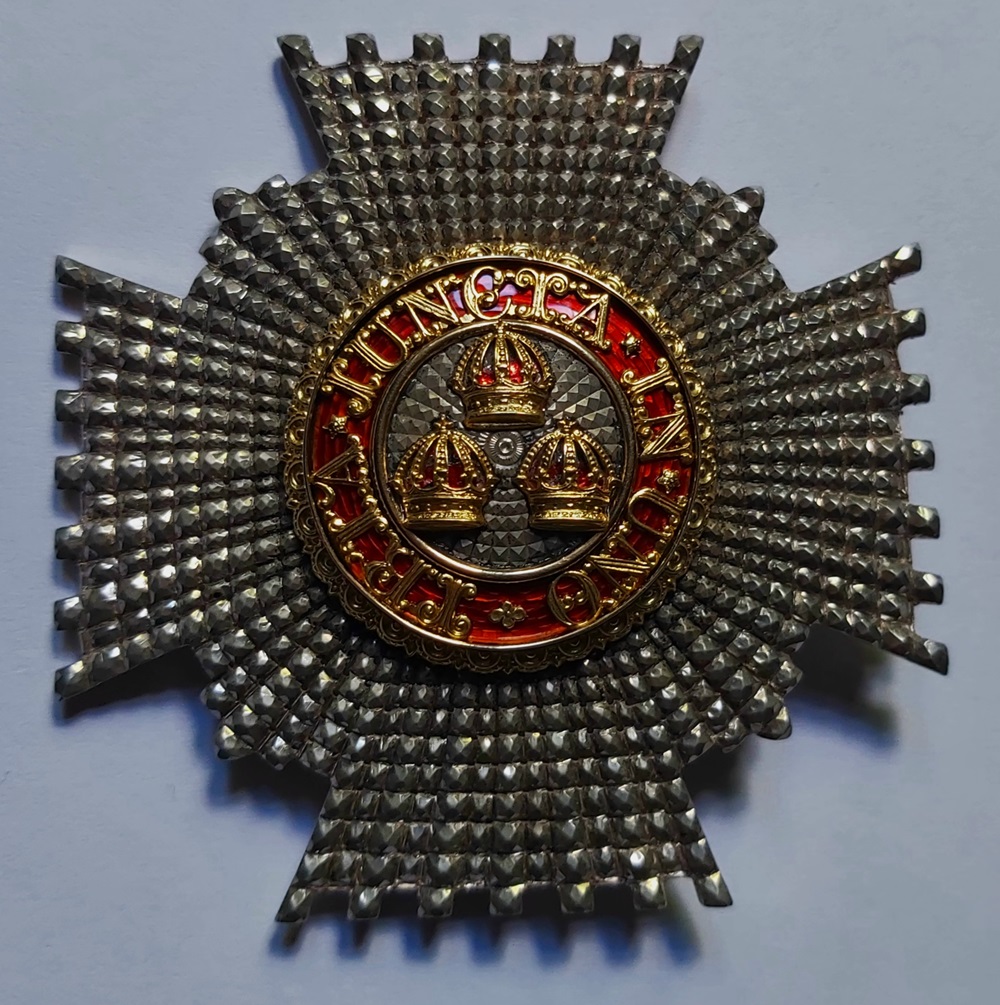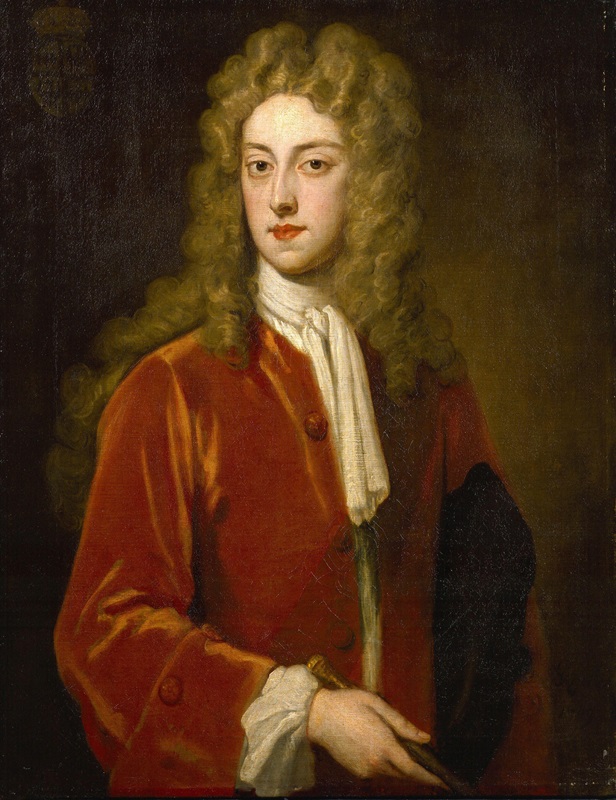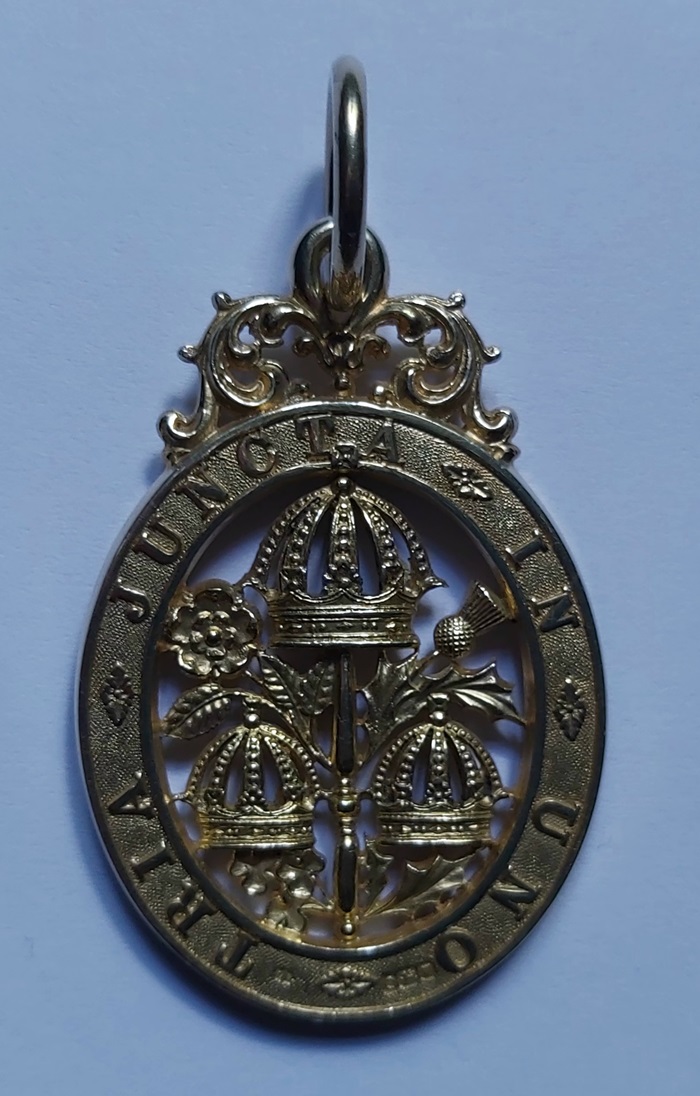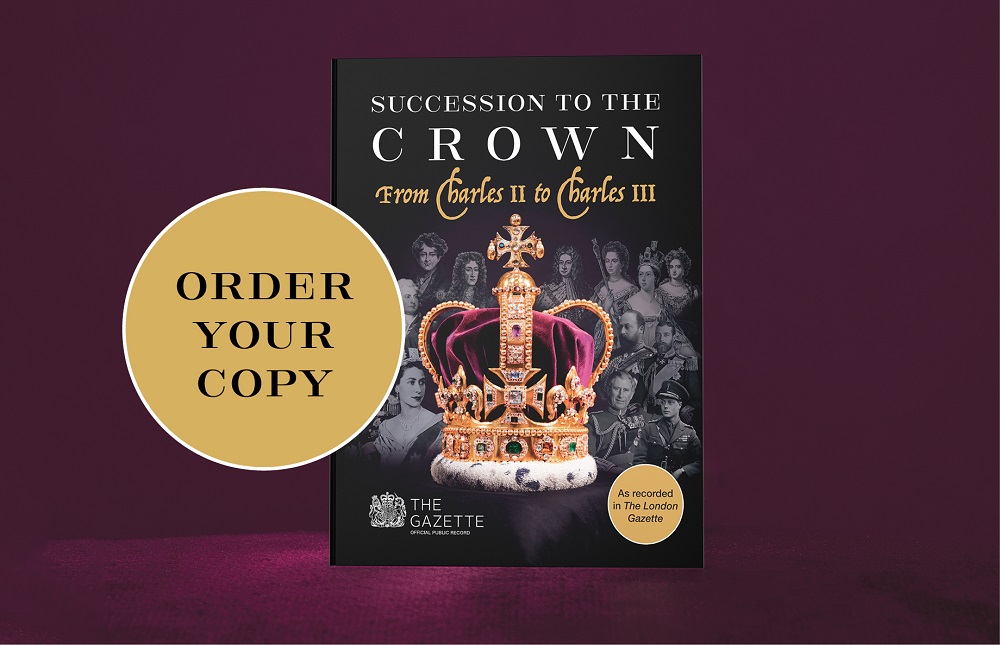A history of the Order of the Bath: Part 1 (Origins)
The Order of the Bath celebrates its 300th anniversary in 2025. In a series of four articles, honours expert Russell Malloch looks at the origins of the Order, some of its notable recipients, and how The Gazette has recorded the history of the Order since 1725.

Introduction
The Order of the Bath celebrates its three hundredth anniversary in 2025. The order was instituted in 1725 and now provides the highest honour that can be conferred by the United Kingdom government; an honour that is routinely granted to the most senior members of the armed forces and civil service, and to foreign heads of state. This series of four articles deals with the creation of the order during the reign of the Hanoverian king George I, and its evolution over the next 300 years.
The series begins by examining the knighthood of the Bath that preceded the formation of the order, and the traces that earlier honour left in The Gazette, which has since recorded the names of more than 15,000 men and women who have joined the organisation.
For most of its history, the Bath recognised the work done by members of the armed forces and civil services, but it started with a political flavour that is seldom found today, as outlined in The Gazette’s recent article about the link between the order and prime minister Sir Keir Starmer.
Knighthood of the Bath
The origins of the Hanoverian order can be traced to an early form of English honour, known as the knighthood of the Bath, which some Plantagenet and Tudor sovereigns used to mark their coronation, and other royal events. The name of the dignity reflected the ritual of bathing, a ceremony associated with admission to the degree of knighthood, but which had fallen out of use by the time the last Tudor sat on the throne. The old style of knights were not members of a properly constituted order, which was governed by statutes or rules of the sort that regulated the rights, rituals and insignia of the knights of the Garter.
The special form of knighthood survived under the Stuarts, and measures were taken to revive the honour to mark Charles II’s English coronation, following the collapse of the protectorate and the restoration of the monarchy. After a preliminary service in Westminster Abbey the knights of 1661 put on a red mantle and proceeded to Whitehall to receive “the riband with the order”, which consisted of an oval badge, showing three crowns within the motto tria juncta in uno (three joined in one), an emblem that was later adopted by the Order of the Bath. The ritual was conducted on the sovereign’s behalf by commissioners, including Edward Montagu, Earl of Manchester, a knight of the Garter and the Bath, and a near relative of the Duke of Montagu who played a central role in the events of 1725.
The knights of 1661 were mainly the heirs to English peerages, baronets and members of the House of Commons, including men such as Francis Godolphin and Edward Harley, whose sons held senior government positions during the early 18th century and became earls and knights of the Garter, and Edward Walpole, whose grandson Robert may be regarded as the founder of the modern Order of the Bath.
No Bath nominations were made to mark the coronations of 1685, 1689 and 1702, or the crowning of the first Hanoverian sovereign in 1714. There were, however, a few references to the old honour in The Gazette, starting with a Garter investiture that was attended by the Earl of Manchester, who helped with the Bath’s Stuart ceremony (Gazette issue 110). The knights of 1661 were occasionally noticed in later editions, as in 1689 when Sir Edward Hungerford was gazetted as a member of the Westminster Convention (Gazette issue 2418), and Sir John Nicholas was sworn in as a clerk of the Privy Council (Gazette issue 2430).

Order of the Bath
Memories of the old knighthood were still current among many of England’s noble and landed families when in May 1725 The Gazette reported that (Gazette issue 6376):
“His Majesty has been pleased to re-establish that degree of knighthood which hath been [de]nominated the Knighthood of the Bath, and to erect the same into a regular military order for ever, by the name and title of the Order of the Bath; and to appoint his grace John Duke of Montagu to be the first great master of the said order”.
The order was created by letters patent on 18 May 1725. The instituting document was issued in the name of the king, but it reflected the work done under the guiding hand of John Montagu, and during the premiership of Robert Walpole, whose grandfather had secured the old form of knighthood in 1661. The order therefore began its life as a political creature with a few royal trimmings, and it would retain that character in the years that lay ahead.
The Duke of Montagu was one of the primary directing minds behind the “revival”, and was assisted in implementing the scheme by John Anstis, Garter king of arms, for whom exaggerated claims were later made as to the importance of his role.₁ Anstis had limited personal and political credentials, while Montagu had strong connections with the existing honours system, and the management of state affairs. By the start of 1725 the duke was the master of the Great Wardrobe, and had acted as lord high constable at George I’s coronation, and held commissions to instal new knights of the Garter (Gazette issue 5758).
Montagu’s wide experience of royal ritual was an important factor when the order began, as he managed its business on the sovereign’s behalf shortly after the king conducted the Bath’s first ceremony and then left to visit his home in Hanover.
Constitution
The founding letters patent made an explicit link with the past, and mentioned the practice of earlier sovereigns “on occasion of certain august solemnities” to confer “with great state, upon their royal issue male, the princes of the blood royal, several of their nobility, principal officers, and other persons distinguished by their birth, quality, and personal merit, that degree of knighthood, which hath been denominated the knighthood of the Bath”.
The patent declared that the old honour would now be erected “into a regular military order”, but otherwise the document was limited in its scope, and only provided that the order was to:
- consist of the sovereign, a great master and 36 companions, who were to be nominated and appointed by the sovereign
- be governed by statutes, that were legally established by being sealed with a seal, showing the sovereign in armour and on horseback, carrying a blue shield showing three gold imperial crowns “the arms usually ascribed to the renowned King Arthur”, with the circumscription “Sigillum honoratissimi ordinis militaris de Balneo”, while the reverse displayed the three crowns impaled with the royal arms
As regards the position of the Bath within the existing honours system, the king was already the sovereign of two orders of knighthood, with the Garter’s 25 places being mainly reserved for members of the royal family and English noblemen, while the Thistle’s 12 members were usually Scottish peers. The Bath therefore doubled the number of ribands that could be distributed by the king and his ministers.
Statutes
The Bath’s original statutes were largely modelled on those of the Garter and began by declaring that the sovereign should be joined by a prince “of the royal blood”, a great master and 35 companions. The only qualification for membership was that nominees should be “gentlemen of blood, bearing coat arms, and void of all reproach”, but without any reference to the earlier attributes of “birth, quality, and personal merit” that were mentioned in the patent.
There were few options as regards the choice of a prince because of the limited size of the royal family, and so the sovereign’s four-year-old grandson William was selected to add lustre to the project by becoming “the first and principal companion”.
The statutes directed that the great master should be appointed because “the important, weighty, and urgent affairs of state and government, will sometime necessarily require the immediate direction of the sovereign, so that he may not conveniently give all the attention requisite for the benefit of this order”. The Duke of Montagu was therefore to have custody of the seal, and to “supply the sovereign’s place, and take especial care, that these statutes, and the ancient rituals belonging to this knighthood be observed with the greatest exactness”.
The quaint statutes required that new members should be instructed by “esquires” in matters of chivalry, and then shaved, bathed and subjected to other “ancient rituals” that were never intended to be performed. Among the quantity of irrelevant detail that Anstis is said to have crafted, the statutes prescribed the oath to be taken by the knights:
“You shall honour God above all things. You shall be steadfast in the faith of Christ. You shall love the king your sovereign lord, and him and his right defend to your power. You shall defend maidens, widows, and orphans, in their rights; and shall suffer no extortion, as far as you may prevent it; and of as great honour be this order unto you, as ever it was to any of your progenitors, or others”.
Members were required to hold a convention each year on 20 October (the anniversary of George I’s coronation), in the order’s chapter room, which was to be the Prince’s Chamber in the Palace of Westminster, and to hear divine service in King Henry VII’s Chapel in Westminster Abbey, which was dedicated to the order’s use.
The statutes permitted a knight to:
- have the precedence that was previously allowed to the old knights of the Bath “by ancient laws, usages, and customs of this realm”
- fix to the back of a stall in Westminster Abbey “an escocheons of his arms enamelled, within a circle gules, having thereon the motto of the order […] under which the name and title of the companion, with the time of his installation”
- place a banner of arms over his stall
- add an emblem of the order to his coat of arms on his seal and furniture
The order was given no fewer than seven officers to serve its 37 members, with the great master having the right to appoint all of them apart for the dean, as that post was attached to the deanery of Westminster Abbey. The Gazette noticed the name of Montagu’s candidates as genealogist, king of arms, messenger, registrar, secretary, and usher.
Montagu and his nominees were able to extract money from the knights, and so the order established a source of patronage, and sinecures that provided fees for the duke and his circle. Honours usually generated income for officials at this period, and a Thistle statute of 1721, for example, had extracted £297 from knights on their admission. The Bath was even more expensive, as its members had to pay more than £300 on accepting their nomination, together with an annual fee of £16.

Insignia
The design of the principal emblem that was worn by the knights or companions was based on the Stuart insignia, and consisted of an oval gold badge, showing the three crowns within the motto “Tria juncta in uno”. The badge was worn from a red riband or sash, and members were sometimes described as being awarded the Red Riband, just as the knights of the Garter received the Blue Riband.
Members also wore a star, with a central emblem consisting of the three crowns and motto, surrounded by eight principal rays of silver. A small version was worn on the left breast of a knight’s coat, with a larger star appearing on the left side of the order’s red mantle.
The knights were entitled to wear a collar, which originally consisted of a series of gold crowns linked with white knots “representing the white laces mentioned in the ancient ceremonials of conferring the knighthood of the Bath”. A statute of November 1725 altered the design of the collar, by adding “roses and thistles, issuing from a gold sceptre” to the crowns and knots.
The Gazette provided information about the insignia that was assigned to the officers. The dean was given the same mantle and badge as the knights, while the other officers wore white mantles with a blue shield containing the three gold crowns on the right shoulder, and badges that included symbols such as a book for the registrar, pens for the secretary, interlaced letters G for the genealogist, and the order’s arms impaled with those of the sovereign for the king of arms.
Membership
The first members were selected by the Walpole administration and named in the original statutes. They ranged in rank from a prince to commoners, and most shared a link with parliament and the politics of the 1720s, as many were returned as members of the House of Commons during the 1722 general election.
Several of the founder members had family connections with the Tudor and Stuart knights of the Bath, and the order was used for family purposes by the prime minister, who allocated places to his son Robert, Lord Walpole, and his son-in-law George, Lord Malpas, while the Duke of Montagu’s son-in-law, Charles, Duke of Manchester, was named at the start.
The knights were mainly from English stock, and held southern dignities, as in the case of the earls of Halifax, Leicester and Sussex, while two places were reserved for the other realms, with Red Ribands for Scotland’s Earl of Deloraine and Lord Glenorchy, and the Irish Earl of Inchiquin and Viscount Tyrconnell. There were baronets among Walpole’s candidates, with places for William Gage, one of the new members from the last general election, and John Hobart, whose sister was the mistress of the Prince of Wales.
The honour was not used to reward naval or military services at the outset, and while the founder knights included two senior officers from the armed forces, it was the case that Admiral Lord Torrington was an MP and later lord of the Admiralty, while Lieutenant-General Charles Wills was another companion who joined the Commons in 1722.
One notable statesman who emerged from the original list was Spencer Compton, the speaker of the Commons, who succeeded Walpole as prime minister in 1742. Speaker Compton’s grandfather and great-grandfather had both accepted the old knighthood of the Bath, as did his uncle John Nicholas, whose Gazette notice was mentioned earlier.
Ceremonial
A number of ceremonies were organised to inaugurate the order and borrowed from the Garter’s ritual. New members received the honour of knighthood (if they had not already done so), which entitled them to use the prefix “Sir”. They were then invested with their riband and badge, and installed in Westminster Abbey, where they received their collar and copy of the statutes.
The Gazette explained that in late May 1725 the king delivered the riband and badge to Prince William, the Duke of Montagu and most of the founder knights, other than the Duke of Richmond, who was suffering from smallpox, and Lord Glenorchy who was on a diplomatic mission to Denmark.
The next step was to hold the first installation, which took place in King Henry VII’s Chapel on 17 June 1725 (Gazette issue 6382). Montagu conducted the ritual as great master, in the absence of the king, who had left for Hanover a few days after the investiture, and did not return to England until January 1726 (Gazette issue 6378). The delegation of the sovereign’s authority was a routine feature of royal ceremonial at this period, and Montagu had already acted as a commissioner at a Garter installation.
The banners of the founder members were already in place in Westminster Abbey when a procession was formed of the knights and their esquires, and the proxies of those members who could not attend. During the main ceremony Montagu delivered the statutes to his son-in-law, after which the dean administered the oath about defending maidens, widows and orphans, and:
“Bath [king of arms] then delivered the collar of the order to the great master, who put it about the neck of the Duke of Manchester, and placing the white hat on his head, seated him down in his stall, who rising, made his double reverences, and the great master having embraced and congratulated him, he then sat down in his stall, covered with his white hat adorned with plumes of white feathers. The great master thus proceeded throughout the residue of the stalls, performing the like ceremonies to the knights and proxies respectively.”
The installation was followed by a religious service and a dinner and led The Gazette’s reporter to conclude that “the whole ceremony was performed with great regularity, magnificence, and splendour.” The report appeared in the same Gazette that advertised “Observations Introductory to an historical essay upon the knighthood of the Bath”, in which John Anstis presented many documents relating to the development of the old honour. It is unfortunate, given his closeness to the proceedings, that Anstis did not mention the role Montagu and Walpole played in instituting the order, choosing the original knights and officers, and commissioning the insignia, banners and other materials that were needed to launch the order.
The ceremonies of 1725 were the only Bath investiture and installation to take place before the demise of King George I, but they enabled the order to embark on its short-lived political career and preceded many hundreds of similar rituals that took place during the next three centuries.
Legacy
The start of the order is recalled in Westminster Abbey, which now houses heraldic memorials for all but one of the knights who took part in the first installation. Examples include the plates for Robert Walpole, John Hobart and Charles Wills, which are in the same stall as those for 20th century members such as Frederick Ponsonby, who helped to create the Order of the British Empire, and Alan Brooke, who was chief of the Imperial General Staff during the second world war. The only missing plate for a founder knight relates to Lord Glenorchy, who served as minister to Denmark and Russia, and was the last surviving founder knight when he died in 1782.
A few of Montagu’s descendants joined the order, among whom was Alice Montagu-Douglas-Scott, the wife of the Duke of Gloucester, who was the great master from 1942 to 1974. The Duchess of Gloucester was named as a dame grand cross of the Bath in 1975 (Gazette issue 46540), shortly before the 250th anniversary of her ancestor becoming the first great master.
There are reminders of the work done by the Duke of Montagu and Sir Robert Walpole in the modern order, as some of the current members wear a mantle, star and badge that are of a similar pattern to those worn by the Hanoverian knights. The undertaking to defend maidens, widows and orphans is part of the modern ritual, and the Bath continues to be served by officers bearing names such as genealogist, king of arms and usher, while the banners of the knights are still hung in Westminster Abbey.
The continuity between the past and present is also illustrated by the location of Montagu’s heraldic plate, which can be found at the stall that is used by William, Prince of Wales, who became the great master of the Bath in 2024 (Gazette issue 64378).

Succession to the Crown: From Charles II to Charles III
Succession to the Crown is essential reading for anyone with a keen interest in the British royal family and provides an excellent and trusted source of information for historians, researchers and academics alike. The book takes you on a journey exploring the coronations, honours and emblems of the British monarchy, from the demise of King Charles II in 1685, through to the accession of King Charles III, as recorded in The London Gazette.
Historian Russell Malloch tells the story of the Crown through trusted, factual information found in the UK's official public record. Learn about the traditions and ceremony engrained in successions right up to the demise of Queen Elizabeth II and the resulting proclamation and accession of King Charles III.
Available to order now from the TSO Shop.
About the author
Russell Malloch is a member of the Orders and Medals Research Society and an authority on British honours. He authored Succession to the Crown: From Charles II to Charles III, which explores the coronations, honours and emblems of the British monarchy.
See also
The Order of The Bath: Prime ministerial K.C.B.s
The Order of the Garter and Queen Elizabeth
Demise of the Crown: An introduction
Find out more
Succession to the Crown: - From Charles II to Charles III (TSO shop)
References
- Anthony Wagner, “Heralds of England” (1967), page 357.
Images
Russell Malloch
Russell Malloch
National Portrait Gallery
The Gazette
Publication date
8 May 2025
Any opinion expressed in this article is that of the author and the author alone, and does not necessarily represent that of The Gazette.
